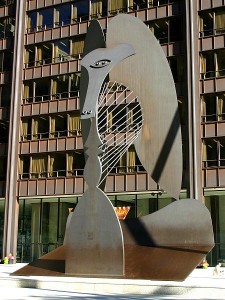Metal Fabrication as Art
June 27, 2013Art can take on many forms: paint applied to canvas, photography, prose, dance, sculptures and much more. Even jewellery, whether crafted from gold, silver or other metals is a form of art. It’s fair to admit, metalwork is likely not the usual thing you’d think of where forms of art are concerned, however, this area of expertise is actually ripe with stunning examples of ingenuity and craft.
From artisan coins to commemorative statues; creative sculptures to contemporary architecture, ironmongers, silversmiths and the like have been creating artistic metal works for centuries, with art and jewellery even being the primary uses of metals in the Americas before the influence of European industrial concepts.
Sculptures and Statues
Worker and Kolkhoz Woman
Originally built for the 1937 World’s Fair in Paris, this colossal monument to communist ideology stands at an impressive 78 feet high, and is now situated in the Russian Exhibition Centre in Moscow. Its creator, Vera Mukhina, designed the couple featured in the stainless steel sculpture to form the shape of the emblematic hammer and sickle symbol of communism, and the work has since been restored for Expo 2010 – the modern day equivalent of the World’s Fair.
Chicago Picasso/The Picasso
 An astounding example of the cubist master’s sculpture work, this untitled piece of fabricated steel is often referred to as the Chicago Picasso, or simply The Picasso. Offered as a gift to the city (the artist is believed to have turned down a fee of $100,000 for the work), Picasso explained that he was happy to be lending his artistic abilities to the “two great gangster cities”, the other being Marseille in France.
An astounding example of the cubist master’s sculpture work, this untitled piece of fabricated steel is often referred to as the Chicago Picasso, or simply The Picasso. Offered as a gift to the city (the artist is believed to have turned down a fee of $100,000 for the work), Picasso explained that he was happy to be lending his artistic abilities to the “two great gangster cities”, the other being Marseille in France.
The piece was completed in 1967, and caused some controversy upon its erection as Chicago had long had a reputation for primarily honouring its historical figures in the art it displayed, not to mention sparking much debate as to the subject of the sculpture, with theories ranging from Picasso’s own Afghan hound to much-featured muse Sylvette David. The artist himself has always remained silent on the subject, not even giving his work an official name.
Coinage
The Dekadrachm of Syracuse with Quadriga and others
The Museum of Fine Arts (MFA) in Boston, USA, recently highlighted an opinion expressed by many: that coins are much more than a method of payment; they are miniature works of art, detailing cultural and political history for all civilisations that used them. The one pictured above, the Dekadrachm of Syracuse with Quadriga, dates from around 465 BC, and is one of the most famous Greek coins in the MFA collection, which also features a Denarius with head of M. Junius Brutus, a 42-43 BC piece that was issued after the assassination of Julius Caesar.
Coin Sculptures
As well as being works of art in their own right, coins have often been regularly used as an artistic building block, or as an inspiration for unique pieces. For example, take a look at Johnny Swing’s Half Dollar / Butterfly Chair on the right. Made from 1,500 fifty-cent pieces and 7,000 welds, the chair is an example of Swing’s coin furniture range that also features sofas and benches.
Weird and Wonderful
Manhole Covers
Many cities worldwide have taken it upon themselves to make artistic features out of their street furniture and industrial elements, whether sanctioned by local government or carried out by rogue artists. For instance, across 95% of Japan’s 1,780 municipalities, one can find detailed and attractive designs on all manhole covers throughout the town or city, unique to that location. The example to the left, taken from a cover in Daito City, demonstrates the colourful designs on offer from the 6,000 works on display – all forged in Nagashima Foundry for express drainage entry.
This entry was posted in Drainage. Bookmark the permalink. ← [Infographic] Updating London’s Victorian Sewer Systems 60 Minute Drainage Callouts, But What Else Can You Achieve In An Hour? →



